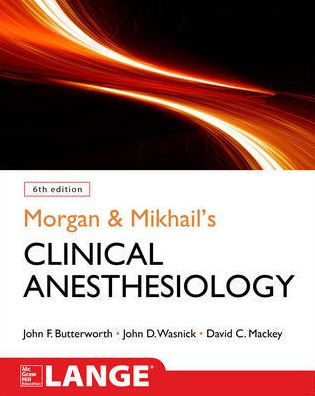
IN FULL COLOR!
Hailed as the best primer on the topic, Morgan & Mikhail's Clinical Anesthesiology has remained true to its stated
goal: "to provide a concise, consistent presentation of the basic principles essential to the modern practice of
anesthesia." This trusted classic delivers comprehensive coverage of the field's must-know basic science and clinical
topics in a clear, easy-to-understand presentation. At the same time it has retained its value for coursework, review,
or as a clinical refresher. This Sixth Edition has been extensively revised to reflect a greater emphasis on critical
care medicine, enhanced recovery, and ultrasound in anesthesia practice.
Key features that make it easier to understand complex topics:
pathophysiology, regional anesthesia, pain management, and critical care
Section I: Anesthetic Equipment & Monitors
Chapter 2: The Operating Room Environment
Chapter 3: Breathing Systems
Chapter 4: The Anesthesia Workstation
Chapter 5: Cardiovascular Monitoring
Chapter 6: Noncardiovascular Monitoring
Section II: Clinical Pharmacology
Chapter 7: Pharmacological Principles
Chapter 8: Inhalation Anesthetics
Chapter 9: Intravenous Anesthetics
Chapter 10: Analgesic Agents
Chapter 11: Neuromuscular Blocking Agents
Chapter 12: Cholinesterase Inhibitors & Other Pharmacological Antagonists to Neuromuscular Blocking Agents
Chapter 13: Anticholinergic Drugs
Chapter 14: Adrenergic Agonists & Antagonists
Chapter 15: Hypotensive Agents
Chapter 16: Local Anesthetics
Chapter 17: Adjuncts to Anesthesia
Section III: Anesthetic Management
Chapter 18: Preoperative Assessment, Premedication, & Perioperative Documentation
Chapter 19: Airway Management
Chapter 20: Cardiovascular Physiology & Anesthesia
Chapter 21: Anesthesia for Patients with Cardiovascular Disease
Chapter 22: Anesthesia for Cardiovascular Surgery
Chapter 23: Respiratory Physiology & Anesthesia
Chapter 24: Anesthesia for Patients with Respiratory Disease
Chapter 25: Anesthesia for Thoracic Surgery
Chapter 26: Neurophysiology & Anesthesia
Chapter 27: Anesthesia for Neurosurgery
Chapter 28: Anesthesia for Patients with Neurological & Psychiatric Diseases
Chapter 29: Anesthesia for Patients with Neuromuscular Disease
Chapter 30: Kidney Physiology & Anesthesia
Chapter 31: Anesthesia for Patients with Kidney Disease
Chapter 32: Anesthesia for Genitourinary Surgery
Chapter 33: Hepatic Physiology & Anesthesia
Chapter 34: Anesthesia for Patients with Liver Disease
Chapter 35: Anesthesia for Patients with Endocrine Disease
Chapter 36: Anesthesia for Ophthalmic Surgery
Chapter 37: Anesthesia for Otolaryngology-Head & Neck Surgery
Chapter 38: Anesthesia for Orthopedic Surgery
Chapter 39: Anesthesia for Trauma & Emergency Surgery
Chapter 40: Maternal & Fetal Physiology & Anesthesia
Chapter 41: Obstetric Anesthesia
Chapter 42: Pediatric Anesthesia
Chapter 43: Geriatric Anesthesia
Chapter 44: Ambulatory & Non-Operating Room Anesthesia
Section IV: Regional Anesthesia & Pain Management
Chapter 45: Spinal, Epidural, & Caudal Blocks
Chapter 46: Peripheral Nerve Blocks
Chapter 47: Chronic Pain Management
Chapter 48: Enhanced Recovery Protocols & Optimization of Perioperative Outcomes
Section V: Perioperative & Critical Care Medicine
Chapter 49: Management of Patients with Fluid & Electrolyte Disturbances
Chapter 50: Acid-Base Management
Chapter 51: Fluid Management & Blood Component Therapy
Chapter 52: Thermoregulation, Hypothermia, & Malignant Hyperthermia
Chapter 53: Nutrition in Perioperative & Critical Care
Chapter 54: Anesthetic Complications
Chapter 55: Cardiopulmonary Resuscitation
Chapter 56: Postanesthesia Care
Chapter 57: Common Clinical Concerns in Critical Care Medicine
Chapter 58: Inhalation Therapy & Mechanical Ventilation in the PACU & ICU
Chapter 59: Safety, Quality, & Performance Improvement


